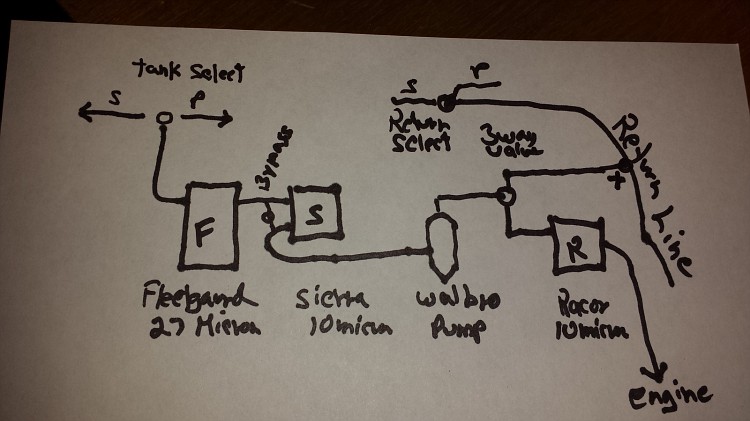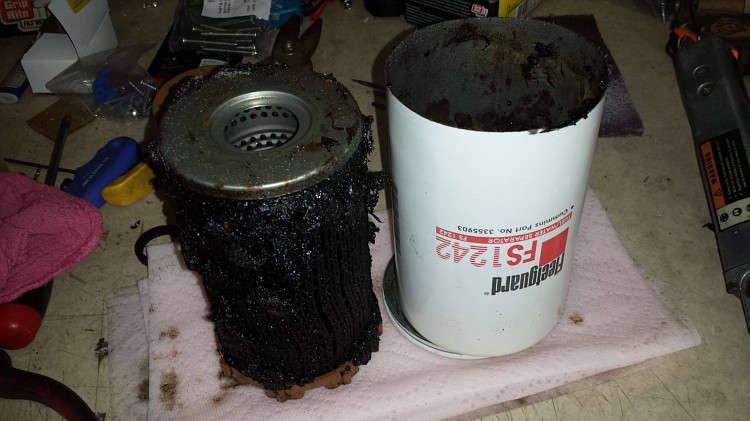Capt.Bill11
Guru
could too fine a filter over burden your fuel pump ??
The flow rate for, Racor filters at least, is the same no matter which micron size element you use in them.
could too fine a filter over burden your fuel pump ??
The flow rate for, Racor filters at least, is the same no matter which micron size element you use in them.
I also have a multi-stage setup. 30 micron to 10 micron then the on engine filters which are supposedly 7 micron.
Very nice setup. I have never gotten a load of bad fuel but I think the idea of adding a course Fleetguard before the dual Racors would be great to have just in case.
.
Most of the crap in our fuel is way over 30mic, so a 30 is fine for primary. .
Heron
Now this is a great setup. By the book, ready for a load of bad fuel (hoping of course it never happens) and with an easily changed fleet guard. What engine?




Agreed- and for what it is worth I became aware of more than a coupled of fuel docks that just remove the filter element from their fuel pumps and let the pump run without one - looks like it has a filter from the outside.
Agreed- and for what it is worth I became aware of more than a coupled of fuel docks that just remove the filter element from their fuel pumps and let the pump run without one - looks like it has a filter from the outside.
Greetings,
Mr. 477.
1) Don't know. All I see is red.
2) Naked eye. If it's not black, it's good.
3) Again, don't know
4) I think the ONLY thing a vacuum gauge will tell you is the state of your filter element.
5) Although I have not experienced any "bad" fuel AFAIK...my criteria would be if it doesn't burn, it's bad.
On our first filter change after getting our current boat there was a small layer of black "stuff" in the bottom of the clear bowl. Using long cable ties to dislodge the more stubborn bits and draining the "stuff" out the bottom we have experienced no other visible contamination since. This was about 12 years ago.
"How does one remove the filter element from a spin on"
.

A question please - I have heard from 'friends' that they like to look at the fuel through the clear fuel bowls to detect the fuel quality. I have seen very little value in that myself. Over the years I have asked questions such as these to these folks but never get an answer I can use effectively....
- What fuel color is good vs bad?
- What do you use to 'detect' the color tint? (how do you compare it)
- How do you tell what % of the color is dyed"
- What do you do when you see it is bad?
- For those that have vacuum gages what is the correlation between color and the vac gage movement?
- How bad do you think the fuel needs to be to show a noticeable/measurable color change within a 3" cylinder?
My intent is not to start an argument , nor get anyone 'upset', nor turn this into an 'anchor type' discussion.
The only goal is to learn what the advantages may be that are measurable, recordable and teachable to others.
Your questions make no sense.
Looking into the bowl has nothing to do with the color of the fuel. It's all about seeing a build up of crud and/or water in the bowl.
If you bowl normally remains clean and water free and you start seeing a build up you may have a fuel issue that you didn't before.
Doesn't matter what color the fuel is.
Smitty
- It will not be cleaner
But it will not be dirtier.
- If you only put in perfectly clean fuel you do not need the initial filter
Not going to happen
- Most all of us cannot get perfectly clean fuel
See above
- If you only travel a few miles a season filters may not be important to you
We travel a few hundred hours per yer 400-600.
- If you cruise extensively you will eventually get a load of fuel that is less than desired
Done that!
- When that happens the 2 mic filter will be overwhelmed within an hour or two
True, I have changed six filters on one load of fuel. Just money. But in your case if your primary is 30 micron and you take on fuel that had crud in it that is 10 to 20 micron it passes your 30 and your then changing the engine mounted secondary with is harder in my case and more expensive.
- You then have the cos
Capt Bill - I agree with your post , color means nothing to me either that is why I am trying to understand what other folks mean when they say they are looking at the color.
Build ups of crud and or water will show up on the vacuum readings used to detect that. I only had water on one used boat once - and it was not just a little bit as most of us know the diesel pickups are typically well above the tanks bottom. Thank you
[Smitty
I have dual Racors on each engine, easy to switch with a lever, each twin Racors has a vacuum gauge with a recording needle when it gets to 7 or higher I switch to the other Racor and replace the bad filter.
